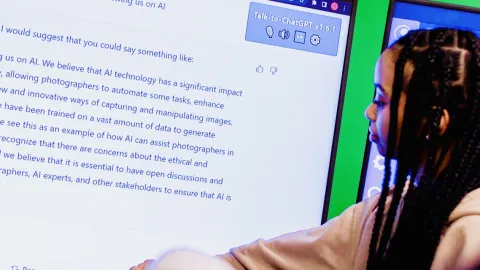From science fiction to classroom reality: How this UBC instructor is using AI as a teaching tool

Hiring a new teaching assistant usually means reading stacks of resumes, conducting interviews, and checking references — but what if they aren’t human?
Meet ChatGPT and GitHub Copilot, two new artificial intelligence-powered teaching assistants (created by OpenAI and Microsoft, respectively) that are ready and available to help third-year engineering physics students at UBC who might be looking for help with their homework or assignments.
While students do have the option of talking to two real-life human TAs in the third-year course, they sometimes need help with a problem afterhours or have a quick question that can be easily answered by the AI TA. Having the option of an AI TA means students can finish their assignment more quickly without getting stuck on a simple question, which also frees up time for the human instructors so they are able to help students with more challenging questions, says instructor Ioan “Miti” Isbasescu.
The human TAs also appreciate AI assistance, as it helps reduce the “bottleneck” of low-level questions so they can help students more quickly with difficult questions that AI TAs aren’t as helpful with answering, he adds.
“Ten years ago, software developers were worried that AI was going to take their jobs away. But today, it’s not AI that is going to take their jobs away — it’s other software developers who are using AI to augment their abilities so they are now 10 times more productive,” said Isbasescu, who is the head of software systems in the UBC Engineering Physics project lab. “In two years, these students will graduate and use these tools in their professional life. It’s important to try to keep up with not only the technical implementation of these systems, but also the implications they have on the future of our work, education and society at large.”
Using AI to enhance student learning
Generative AI has been making waves in many industries in recent months, and education is no exception. As the capabilities and usage of AI continue to grow, so have concerns about the ethical use of the technology and potential risks of academic misconduct. UBC has taken an educative approach to AI when it comes to academic integrity, looking at how courses can be designed to support academic integrity and providing information to instructors about using AI in the classroom.
Rather than fear the technology, some UBC professors like Isbasescu are finding innovative ways to integrate it into their course curriculum to enhance student learning.
In Isbasescu’s course, students use AI and machine learning to learn how to control virtual cars driving around in a virtual environment. With ChatGPT’s recent release, he said this year he decided to explicitly instruct students to use AI when they generate code for labs and homework assignments. He believes it is important for students to learn how to use the technology for their assignments as they will need to know how to use it when they enter the workforce.
“AI is like a calculator — a very high-end calculator,” explained Isbasescu. “You put in some information and it’s going to tell you what it thinks is the answer. But, just like with a calculator, if you don’t understand its limitations, you can make a lot of mistakes. My course is like a sandbox where students get to play around with AI so they can experience the traps and dangers with these systems, but also learn how to use it in a way that can help them.”
To reduce the risk of cheating, students who use the AI TA for their homework and lab assignments are required to give a weekly oral update to their instructor and the human TAs about how they used the tool for the assignment. Students also submit their written interactions with the AI as part of their homework. In some cases, Isbasescu says students have submitted more than 50 pages of conversation with ChatGPT.
“It’s still early days, but I believe that using AI in this way can improve the student’s understanding of the material,” he said. “We ask the students not only to describe the problem in precise detail to the AI, but they also need to understand what are the trade-offs of adopting the AI solutions. By the time students get the AI to solve the problem, they understand the material so well that they can already develop a solution themselves.”


